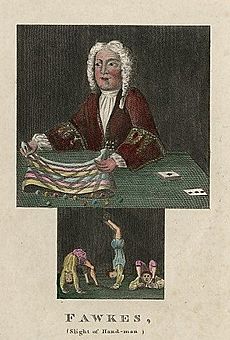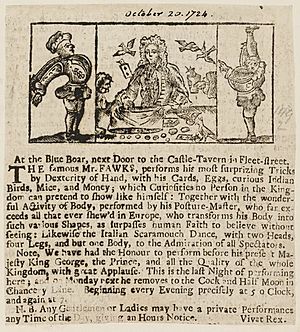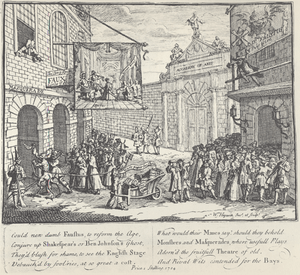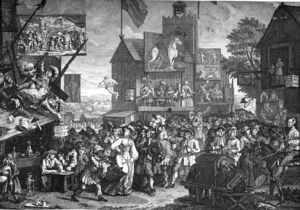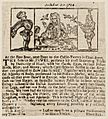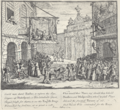Isaac Fawkes facts for kids
Isaac Fawkes (born around 1675, died 1732) was a famous English magician and showman. He was one of the first magicians to perform magic as entertainment outside of traditional fairs. Through clever advertising and managing his shows, he became very famous and earned a lot of money. Even though his simple shows were made fun of by artist William Hogarth, important people in society continued to enjoy his performances until he died in 1732. He worked closely with Christopher Pinchbeck, who made clocks and amazing moving machines. From the mid-1720s, Fawkes started showing off Pinchbeck's inventions in his acts, sometimes as part of his magic tricks and sometimes as separate displays.
Contents
How Isaac Fawkes Became Popular
We don't know much about Isaac Fawkes before 1722. That year, an advertisement announced that his son would perform tumbling at a fair. However, another ad in March 1722 said Fawkes had already performed for King George II. This means he was likely well-known in London before then.
Fawkes' Early Performances
In his early shows, Fawkes performed:
Tricks by Dexterity of Hand, with his Cards, Eggs, Corn, Mice, curious India Birds, and Money...Likewize the surprising Activity of Body perform'd by his Little Boy, of 12 Years of Age...
The 12-year-old boy was Fawkes' own son. He was a "Posture Master," which means he was a contortionist who could bend his body in amazing ways. Fawkes often boasted that his son was the best Posture Master in Europe. Because this act was so popular, he hired another younger boy to do similar, but different, contortion acts.
Changing the Image of Magic
Fawkes wasn't the first fair magician, and his tricks weren't always new. However, he was one of the first to successfully sell his shows to fashionable society outside of fairs. He did this by making it clear that his magic was just entertainment, not real magic or trickery. He didn't want people to think he was using dark forces.
Fawkes didn't wear the usual magician's cloak and hat. Instead, he dressed like a gentleman with a powdered wig and a smart suit. He emphasized his skill and cleverness. If he ever mentioned dark forces, it was only to make fun of other magicians who claimed to have supernatural powers. One writer said that Fawkes became rich because he understood what people wanted to see.
Not everyone believed he was honest. One writer in 1819, James Caulfield, described Fawkes as someone who tricked people out of their money with his clever tricks.
Fawkes' Show Locations
Fawkes regularly performed at big fairs like Southwark and Bartholomew, sometimes doing up to six shows a day. As he became more popular, he set up shows in London even when it wasn't fair season. In early 1723, he performed at the French Theatre, where he put on a show for the Prince and his friends and was "handsomely rewarded."
By April 1723, he moved to a large booth in Upper Moorfields, performing three times a day. After the fair season, he had a booth at Tower Hill. By December, he was back in the Haymarket, sharing a building with famous events like masquerades and operas. By setting up his show next to these popular events, he became a central part of London's fashionable entertainment scene.
Promoting His Success
Fawkes was not shy about his success. In late 1723, a newspaper ad proudly stated that he had put "seven hundred Pounds into the Bank" since the last fairs. He even challenged other magicians to show they could save as much money.
Fawkes used newspapers, journals, and posters a lot to promote himself. He told the public about his upcoming shows, his performances for rich and famous people, and how well his career was going. He also changed his ticket prices, from sixpence to two shillings, depending on the audience and where the show was.
Hogarth's Views on Entertainment
The artist William Hogarth didn't like how popular "low" entertainments, like Fawkes' shows, were becoming instead of "high" art. In his 1723 print called Masquerades and Operas (or the Bad Taste of the Town), he made fun of people for liking these "foolish" shows.
Hogarth saw Fawkes' popularity as a sign of what the public was like. As part of his act, Fawkes would make money appear from nowhere. Hogarth might have seen this as similar to the hopes of people who invested in the "South Sea Bubble," a big financial scam that Hogarth had also made fun of. Fawkes' show also appears in Hogarth's later print, Southwark Fair, from 1735. Even though Fawkes had died by then, the picture shows his booth.
Hogarth's art didn't seem to hurt Fawkes' business much. By the time the print came out, Fawkes had made enough money that he didn't need to perform as much. In February 1724, he even announced he would retire at the end of that year's fair season, possibly because of a problem with one of his legs. However, he never actually quit and was planning to visit Bristol with his show that July.
Expanding His Amazing Show
One of Fawkes' advertisements described his act in great detail:
He takes an empty bag, lays it on the Table and turns it several times inside out, then commands 100 Eggs out of it and several showers of real Gold and silver, then the Bag beginning to swell several sorts of wild fowl run out of it upon the Table. He throws up a Pack of Cards, and causes them to be living birds flying about the room. He causes living Beasts, Birds, and other Creatures to appear upon the Table. He blows the spots of the Cards off and on, and changes them to any pictures.
Fawkes performed for several years at the Old Tennis Court playhouse in James Street, which became known as "Fawkes' Theatre." Ads for his shows there showed he was making his performances bigger and better. He was always willing to do private shows and teach students.
Working with Christopher Pinchbeck
Fawkes formed a close partnership with Christopher Pinchbeck, who made clocks and amazing moving machines called automata. Pinchbeck created many of the devices Fawkes used from the late 1720s. The first time Pinchbeck's work appeared in Fawkes' show was in a 1727 ad for the "Temple of Arts." It described:
... with two moving pictures, the first being a Consort of Musick performed by several figures playing on various instruments with the greatest Harmoney and truth of time, the other giving a curious prospect of the City and Bay of Gibraltor, with ships of war and transports in their proper motions, as tho' in real action; likewise the Spanish troops marching thro' Old Gibraltor. Also the playing of a Duck in the river and the Dog diving after it, as natural as tho' alive. In this curious piece there are about 100 figures,all of which show the motions they represent as perfect as the life; the like of it was never seen in the world.
Fawkes' famous trick of making an apple tree grow from a seed and produce ripe apples in less than a minute also used Pinchbeck's inventions. Fawkes slowly started to include demonstrations of Pinchbeck's automata in his shows, alongside his magic tricks and his son's contortionist acts. One of Pinchbeck's creations was the "Venetian Machine," which was like an early scrolling diorama showing moving scenes.
Pinchbeck usually wasn't mentioned much in Fawkes' shows, but their partnership was strong. Fawkes slowly changed his shows to focus more on Pinchbeck's designs. He still performed his magic at fairs, but he highlighted tricks based on Pinchbeck's inventions and displayed Pinchbeck's automata and clocks. He gave these shows fancy names like the "Grand Theatre of the Muses."
Then Ralph upon Dobbin and Joan upon Ball,
Jog away to the Fair both the Great and the Small;
But be sure don't forget this strange Man to behold,
Who turns Cards into Mice, and from nothing makes Gold.
By using Pinchbeck's creations, Fawkes could show that his act was about clever machines and skill, not black magic. He became more like the "natural philosophers" of his time, who were early scientists demonstrating new discoveries in entertaining ways. However, Fawkes still used humor about spirits for promotion. A 1726 ad for a show jokingly mentioned his "auxiliary Spirits and Demons, shut up in a Bottle for Conveniency of Carriage."
Other Acts in Fawkes' Show
Fawkes also added a Punch and Judy puppet show to his act, working with the son of a famous puppeteer named Martin Powell. Sometimes, Fawkes and Powell were rivals for audiences at the fairs.
By 1726, Fawkes' show was very diverse. It included:
first his surprising Dexterity of Hand, in which he far exceeds all that ever pretended to the same Art, with his Cards, Eggs, Mice, Money, and several curious Birds from divers Parts of the World that never were seen here before. 2d. His Famous Posture Master, who is allowed to be the best in Europe of that kind. 3d. His Musical Clock that plays Variety of Tunes of Tunes on the Organ, Flute and Flagelet, with Birds whistling and singing as natural as Life. 4th. His Puppet Show, with the Comical Humours of Punch and his wife Joan: Like-wise a Court of the richest and largest Figures ever shown in England, being as big as Men and Women.
He also added a "Horned Woman," Elizabeth French, to his show. She had a 10-inch horn-like growth on the back of her head. She worked for Fawkes for several years until she accidentally knocked the growth off.
Fawkes' success continued. In 1730, he performed for "Indian Princes." In 1731, he gave a show to the Algerian ambassador and other important people. He showed them the apple tree illusion and a moving scene of Algiers in the Venetian Machine. The visitors were so amazed that, after tasting the apples from the fast-growing tree, they refused to touch anything else that belonged to him!
Isaac Fawkes' Death and What Happened Next
In early 1732, while Fawkes was performing at a fair, a fire broke out in a nearby booth. This fire scared his wife, Alice, so much that she had to give birth early. We don't know if this fire was connected to Fawkes' death later that year.
Isaac Fawkes died on May 25, 1732, and was buried three days later. He had saved a lot of money, leaving his wife Alice a large fortune. Reports at the time said he had "honestly acquired a fortune of above ten thousand pounds," which was a huge amount back then.
After Fawkes died, Christopher Pinchbeck's younger son, Edward, took over the business with Fawkes' son. Edward married Fawkes' widow, Alice, in November. Fawkes' show continued to do well for a while under their management. In 1733, they still showed clocks and automata at Bartholomew Fair. However, they slowly started to focus more on puppet shows. Although they were still advertising their booth in 1741, they seem to have stopped performing after 1746.
There are only a few pictures of Isaac Fawkes. One is a basic drawing by Sutton Nichols, which was also used in one of his old advertisements. The best-known image is a detail from a souvenir fan from Bartholomew Fair, possibly painted around 1740. It shows Fawkes on the promotional banner of his show stand.
Images for kids


